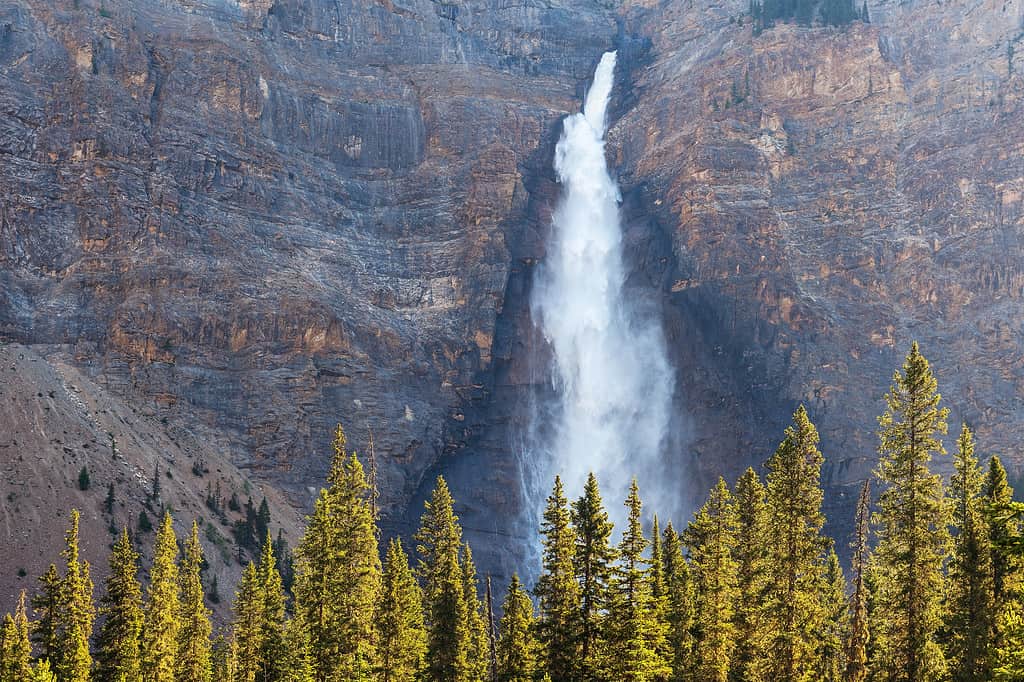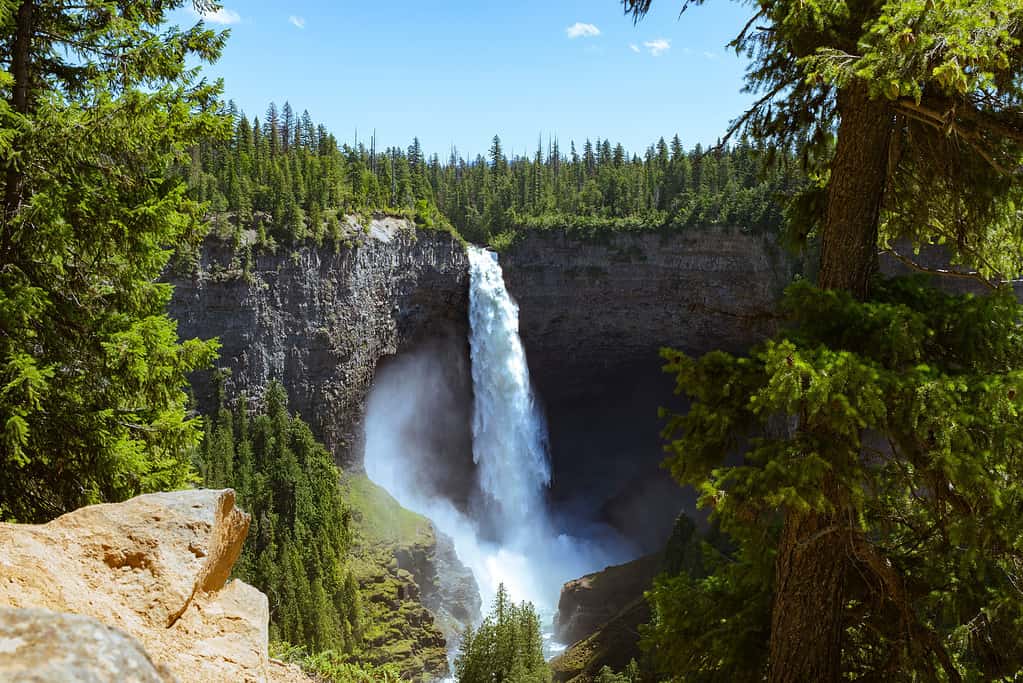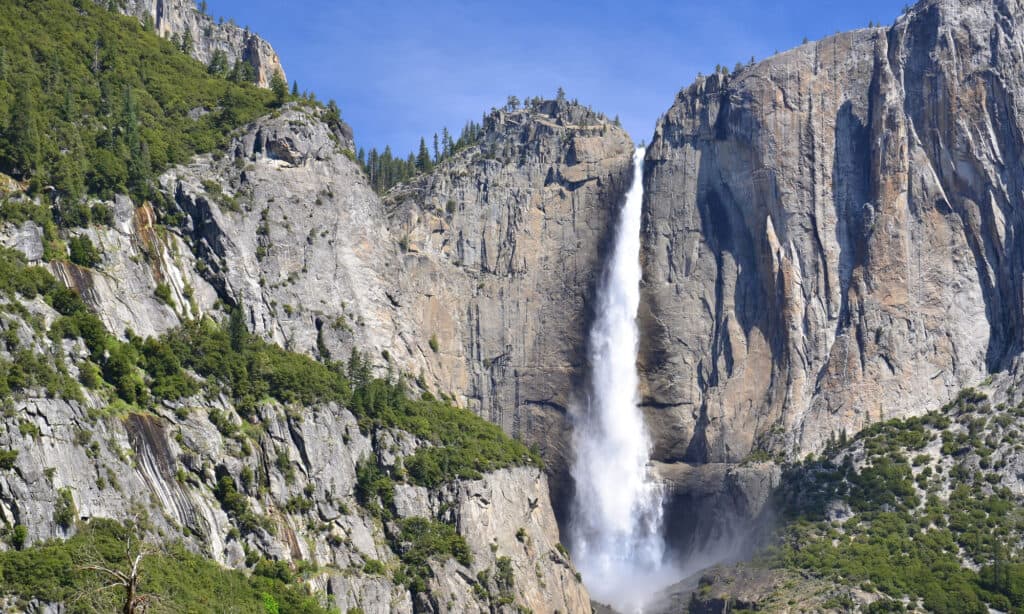The Rocky Mountains, with their rugged grandeur and breathtaking landscapes, are not only a haven for hikers and nature enthusiasts but also home to some of the tallest waterfalls in North America.
These cascading wonders, hidden amidst the pristine wilderness, offer a symphony of sights and sounds that will leave you in awe.
In this article, we’ll take you on a journey to explore the tallest waterfalls in the Rocky Mountains, providing essential details, hiking opportunities, wildlife encounters, and photography tips for each of these natural wonders.
1. Takakkaw Falls

Takakkaw Falls, located in Yoho National Park, British Columbia ranks as one of the tallest waterfalls in the Rocky Mountains at 1,250 feet.
©SL_Photography/iStock via Getty Images
Height: Soaring at a staggering 1,250 feet, Takakkaw Falls in Yoho National Park, British Columbia, ranks as one of the tallest waterfalls in the Rocky Mountains.
Location: A part of Yoho National Park, you can reach Takakkaw Falls by a short drive from Field, British Columbia. A well-maintained parking area is available.
Hiking Opportunities: For a closer view, follow the easy, paved pathway to the base of the falls. More adventurous hikers can explore the Yoho Valley Trail, a 7.2-mile hike offering stunning views of the falls and surrounding landscapes.
Wildlife Watching at Takakkaw Falls
Keep an eye out for bighorn sheep, mountain goats, and black bears in the area.
What Makes it Special: Takakkaw Falls is known for its awe-inspiring height and the deafening roar of water as it plummets down. The best time to visit is in late spring or early summer when the snowmelt fuels the falls’ power.
Photography Tips: Capture the falls in all their glory by using a wide-angle lens to encompass the entire scene. Slow down your shutter speed to achieve the mesmerizing silky effect of the waterfall.
2. Helmcken Falls

Helmcken Falls in Wells Gray Provincial Park, British Columbia, stands tall at 463 feet.
©Wirestock/iStock via Getty Images
Height: Helmcken Falls, in Wells Gray Provincial Park, British Columbia, stands tall at 463 feet, making it another noteworthy waterfall in the Rockies.
Location: Found in Wells Gray Provincial Park, you can access Helmcken Falls via a well-marked road, approximately 45 minutes from Clearwater, British Columbia.
Hiking Opportunities: A short and accessible trail offers a panoramic view of the falls and the Helmcken Canyon. For the more adventurous, the park boasts various hiking opportunities.
Wildlife Watching at Hemlcken Falls
Keep your binoculars handy for a chance to spot moose, black bears, and various bird species.
What Makes it Special: Helmcken Falls is renowned for its force and beauty. Spring and early summer are the best times to visit when water flow is at its peak.
Photography Tips: Use a tripod to capture the falls in low light conditions. Experiment with different angles to showcase the waterfall’s immense power.
3. Bridal Veil Falls

Bridal Veil Falls in Telluride, Colorado is unique for its delicate appearance, resembling a bridal veil.
©Wirestock/iStock via Getty Images
Height: Cascading gracefully from a height of 365 feet, Bridal Veil Falls in Telluride, Colorado, is a captivating sight.
Location: You can reach Bridal Veil Falls by taking a scenic drive up Black Bear Pass Road, southwest of Telluride.
Hiking Opportunities: Hikers can take a moderately challenging trail to reach the base of the falls. The area also offers excellent off-roading experiences.
Wildlife Watching at Bridal Veil Falls
Look out for mule deer, mountain goats, and various bird species along the trail.
What Makes it Special: Bridal Veil Falls is unique for its delicate appearance, resembling a bridal veil, and its accessibility, which allows visitors to experience the falls up close. Late spring and early summer are ideal for the fullest flow.
Photography Tips: Experiment with different shutter speeds to capture the falls’ ethereal quality. The falls are particularly photogenic during the golden hours of sunrise and sunset.
4. Ribbon Falls
Height: Ribbon Falls, nestled in the heart of the Canadian Rockies, boasts a majestic drop of approximately 1,200 feet.
Location: You can witness the grandeur of Ribbon Falls when hiking along the iconic Icefields Parkway in Alberta, Canada.
Hiking Opportunities: The hike to Ribbon Falls is part of the longer, renowned Bow Glacier Falls Trail. The journey offers a mix of stunning vistas and lush meadows.
Wildlife Watching at Ribbon Falls
Keep your camera ready for glimpses of elk, bighorn sheep, and the occasional grizzly bear.
What Makes it Special: Ribbon Falls is a testament to the raw power of nature. Its remote location, surrounded by pristine wilderness, makes it a serene destination. Late spring and early summer are the prime times to visit.
Photography Tips: Take advantage of the surrounding landscapes to capture Ribbon Falls in its full glory. Wide-angle lenses are perfect for showcasing the falls’ sheer height.
5. Yosemite Falls

At 2,425 feet Yosemite Falls is one of the tallest waterfalls in North America.
©A.Hornung/Shutterstock.com
Height: Yosemite Falls in Yosemite National Park, California, is one of the tallest waterfalls in North America, with a total drop of 2,425 feet.
Location: Yosemite Falls is easily accessible via Yosemite Valley. Just follow the signs within the park.
Hiking Opportunities: A paved trail leads to the base of Lower Yosemite Fall. For a more challenging hike, venture to the top of Upper Yosemite Fall for breathtaking panoramic views.
Wildlife Watching at Yosemite Falls
Keep an eye out for mule deer, black bears, and the elusive bobcat that call Yosemite home.
What Makes it Special: Yosemite Falls is not only stunning but also easily accessible. Spring is the best time to visit when the snowmelt feeds the falls, creating a spectacular display.
Photography Tips: Capture the falls from various angles throughout the day to witness changing lighting conditions. Use a tripod for stability during long exposures.
6. Virginia Falls

Virginia Falls is known for its immense power and the vibrant turquoise color of its waters.
©jvazquezm/iStock via Getty Images
Height: Virginia Falls in Glacier National Park, Montana, cascades down over 490 feet, making it one of the park’s crown jewels.
Location: To reach Virginia Falls, take the scenic drive along Going-to-the-Sun Road and stop at the St. Mary Falls trailhead.
Hiking Opportunities: A moderately strenuous hike along the St. Mary Falls trail will lead you to the awe-inspiring Virginia Falls. The journey offers breathtaking views of the surrounding landscape.
Wildlife Watching at Virginia Falls
Keep an eye out for grizzly bears, mountain goats, and a variety of bird species in Glacier National Park.
What Makes it Special: Virginia Falls is known for its immense power and the vibrant turquoise color of its waters. Late spring and early summer are the best times to witness its full glory.
Photography Tips: Use a polarizing filter to enhance the color of the water. Capture the falls with the surrounding wilderness to emphasize its grandeur.
7. Shoshone Falls

Shoshone Falls is one of the most beautiful sights in all of Idaho.
©Benny Marty/Shutterstock.com
Height: Shoshone Falls, also known as the “Niagara of the West,” boasts a height of 212 feet, making it one of the highest waterfalls in the United States.
Location: Found in Twin Falls, Idaho, Shoshone Falls is easily accessible by car.
Hiking Opportunities: Hiking trails around the park offer excellent vantage points to view the falls from various angles. The area also provides picnic facilities and a playground.
Wildlife Watching at Shoshone Falls
Look out for raptors soaring above the Snake River Canyon and the occasional river otter swimming in the waters below.
What Makes it Special: Shoshone Falls is renowned for its width and the sheer power of water that it carries during spring runoff. Visit in the spring to witness the falls at their peak.
Photography Tips: Capture Shoshone Falls with the Snake River Canyon in the background to showcase the scale of this natural wonder. Use a tripod for long-exposure shots.
The Rocky Mountains, a paradise for nature lovers, house some of North America’s most magnificent waterfalls. From the towering Takakkaw Falls in British Columbia to the enchanting Bridal Veil Falls in Colorado, each of these cascading wonders offers a unique experience.
When planning your visit to the tallest waterfalls in the Rocky Mountains, remember to check the local park websites for trail conditions, seasonal variations, and any permits required. Also, respect the natural environment and wildlife by following Leave No Trace principles.
So, pack your camera, lace up your hiking boots, and prepare to be captivated by the sheer beauty and power of these natural wonders in the heart of the Rockies.
The photo featured at the top of this post is © EB Adventure Photography/Shutterstock.com
Thank you for reading! Have some feedback for us? Contact the AZ Animals editorial team.






